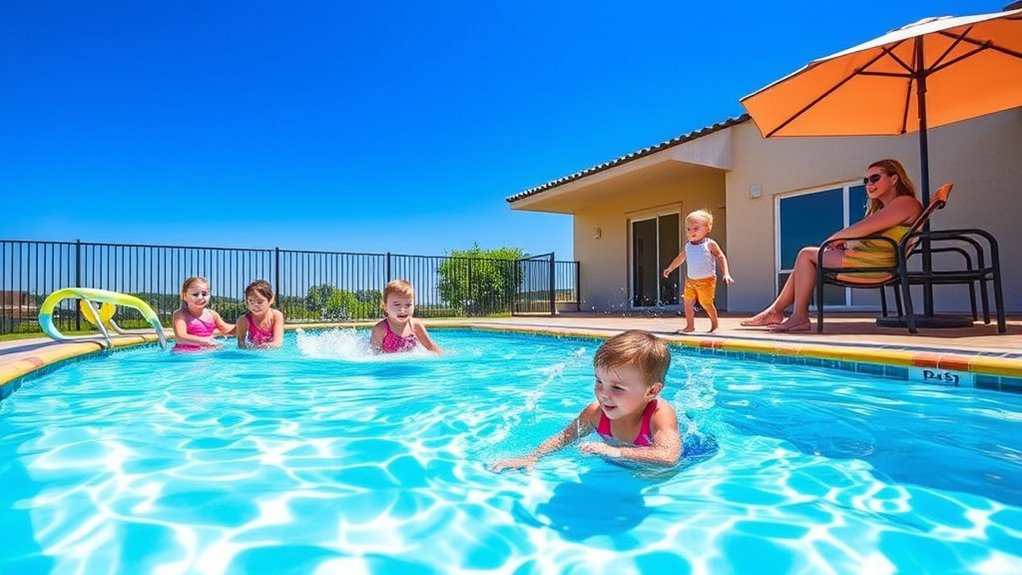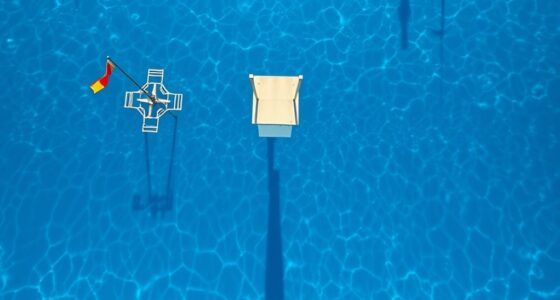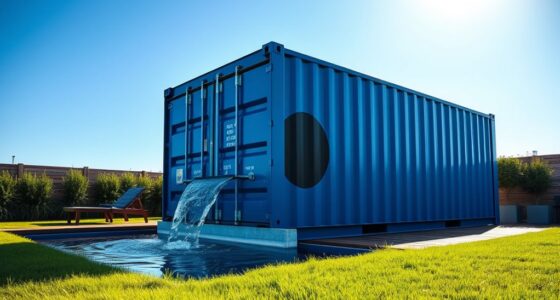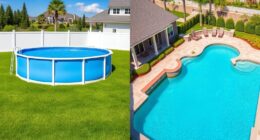To keep kids safe and happy in wading pools, pick a depth of 6-12 inches based on their age and swimming skills. Choose durable, non-slip materials and make certain the pool is placed on flat ground away from hazards. Always supervise children closely and use safety accessories like fences, covers, and alarms. Proper maintenance, seasonal storage, and clear safety rules help prevent accidents. Keep exploring to learn more tips for a safe and fun pool experience.
Key Takeaways
- Keep pool depth between 6-12 inches to ensure safety and allow kids to play comfortably.
- Choose a flat, level location away from hazards and ensure proper drainage and shade.
- Use durable, BPA-free materials with reinforced seams for safety and longevity.
- Install safety features like fences, covers, and alarms; supervise children constantly during pool use.
- Regularly clean, disinfect, and inspect the pool to maintain water quality and prevent accidents.
Choosing the Right Depth for Safety and Enjoyment
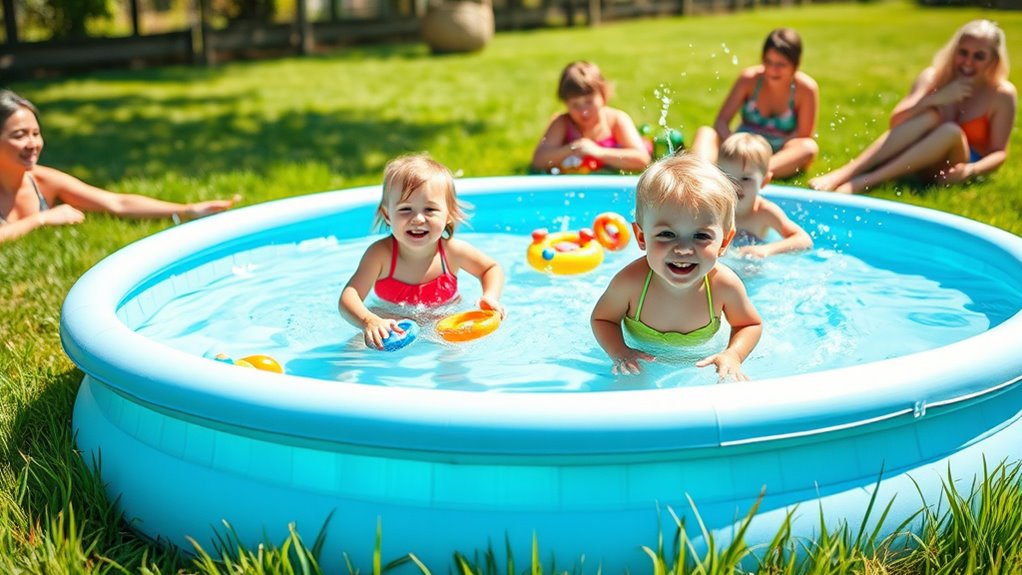
When selecting a wading pool for your kids, choosing the right depth is essential for both safety and fun. You want a pool shallow enough to prevent accidents but deep enough for your kids to enjoy splashing around. Typically, a depth of 6 to 12 inches works well for young children, providing enough water for play without risking submersion. Always consider your child’s age, height, and swimming ability when choosing the depth. Supervision is pivotal, especially in deeper water, but the right depth reduces the risk of drowning or slips. Remember, a pool that’s too deep can make your child feel uneasy, while one that’s too shallow might limit fun. Prioritize safety without sacrificing enjoyment by selecting a suitable depth. Incorporating appropriate pool depth is crucial to creating a safe and enjoyable environment for kids.
Key Features to Look for in a Well-Designed Wading Pool
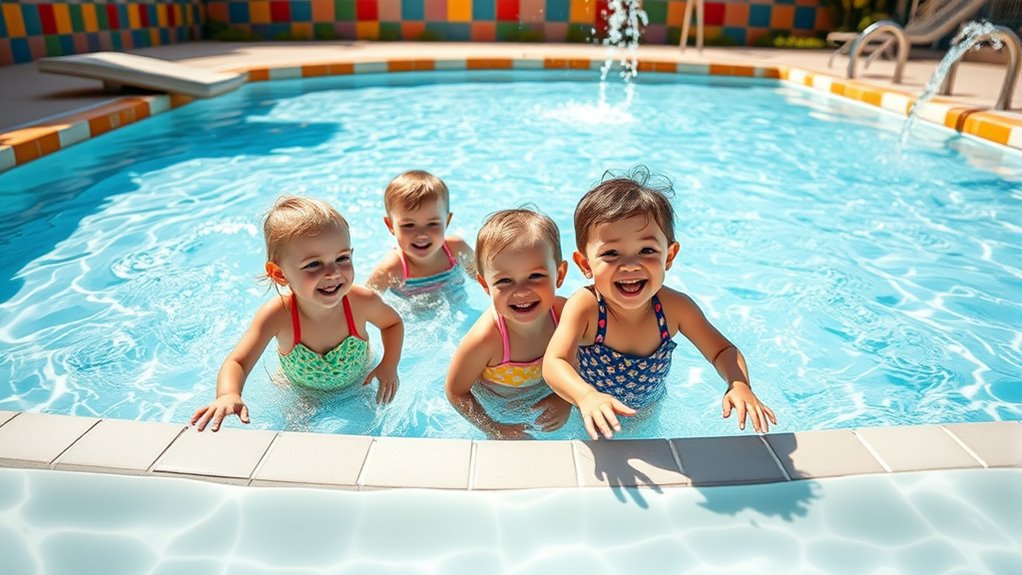
When choosing a well-designed wading pool, you should prioritize safe water depths that match your child’s age and swimming skills. Look for user-friendly features like easy-to-clean surfaces and simple setup options to make your experience hassle-free. These key features guarantee your child can enjoy the pool safely and comfortably. Additionally, considering water quality can help prevent skin irritations and infections, ensuring a healthier swimming experience.
Safe Water Depths
Ensuring the water in a wading pool is at a safe depth is essential for your child’s safety and enjoyment. Ideally, the water should be no deeper than 12 inches, allowing your child to stand comfortably without risk of drowning. Shallow depths help prevent accidents and give you peace of mind while they play. Look for pools with adjustable water levels or built-in barriers to control how deep the water gets. Avoid pools that can fill too high or are difficult to monitor. Remember, even shallow water can be hazardous if your child slips or trips. Regularly check the water level and ensure it stays within safe limits throughout use. Prioritizing safe depths makes water play fun and secure for your little one.
User-Friendly Features
A well-designed wading pool features user-friendly elements that make water play safe and enjoyable for your child. Look for pools with simple setup and easy-to-clean surfaces, so you can spend less time preparing and more time playing. Built-in drain plugs make emptying effortless, reducing mess and hassle. Consider pools with non-slip bottoms to prevent slips and falls, especially when wet. Bright colors and fun shapes can stimulate your child’s imagination and make the experience more engaging. Look for models with stable, sturdy sides that won’t tip over easily. Additionally, features like integrated sunshades or built-in sprinklers add comfort and fun without complicating use. These thoughtful details enhance safety, convenience, and enjoyment during every water adventure. For an extra touch of charm, consider adorable dog-inspired designs that can make your child’s wading pool experience even more delightful.
Materials and Construction: Ensuring Durability and Safety
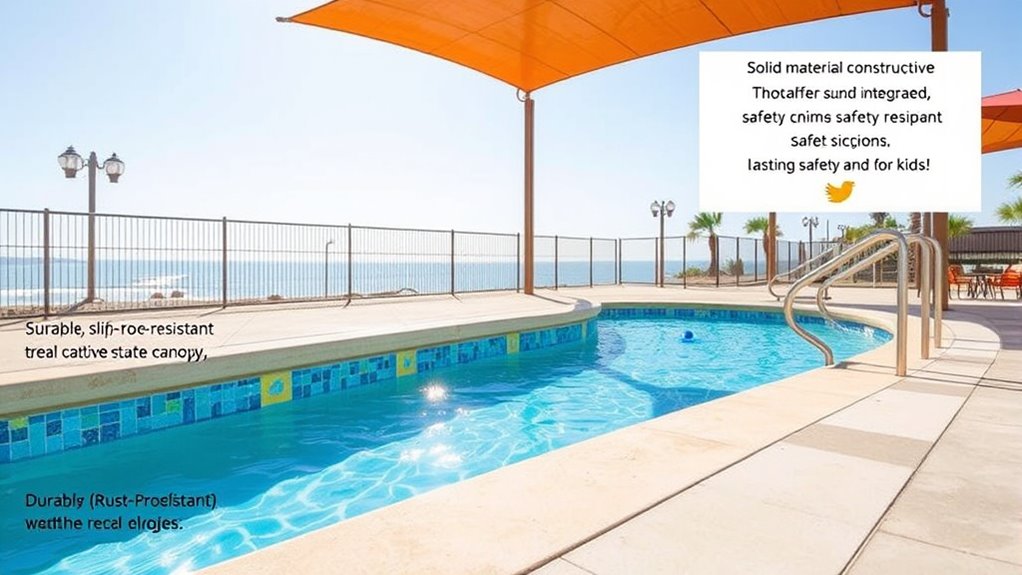
Choosing the right materials and construction methods is crucial for creating wading pools that are both safe and durable. You want materials that withstand weather, resist punctures, and are safe for children. Consider these factors:
- Use high-quality, BPA-free plastic or vinyl for the pool shell to prevent chemical leaks and ensure safety.
- Reinforce seams with strong, waterproof adhesives or heat welding to prevent leaks.
- Opt for sturdy, corrosion-resistant frames or supports if the pool includes structural elements.
- Guarantee the base material provides slip resistance and prevents shifting or sinking over time.
- Selecting materials with anti-slip properties enhances safety, especially when kids are playing in the pool.
Tips for Proper Pool Placement and Surroundings
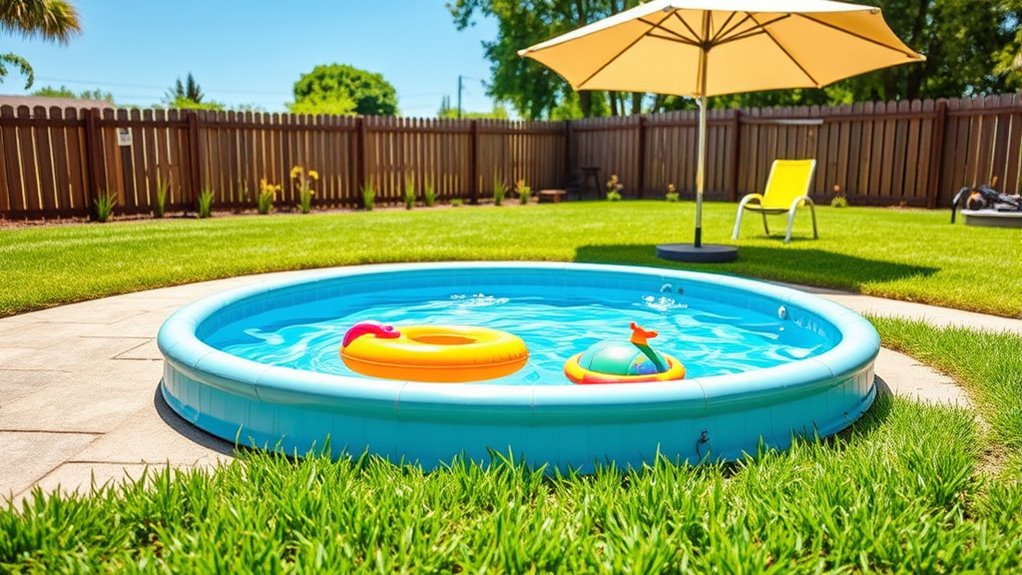
To create a safe and enjoyable wading pool environment, carefully select a flat, level spot away from potential hazards like sharp objects, tree roots, or uneven ground. Guarantee the area has good drainage to prevent water pooling and mud. Keep the pool away from electrical outlets, fences, or busy pathways to reduce risks. Surround the pool with soft, non-slip surfaces like rubber mats or grass. Place the pool in a shaded area to prevent overheating. Use the table below to guide your setup:
| Location Tip | Hazard to Avoid | Surrounding Features |
|---|---|---|
| Flat, level ground | Sharp objects, roots | Soft grass or mats |
| Away from electrical outlets | Electrical hazards | Shade from trees or umbrellas |
| Open space with drainage | Poor water runoff | Clear, unobstructed area |
Supervision and Adult Involvement During Water Play
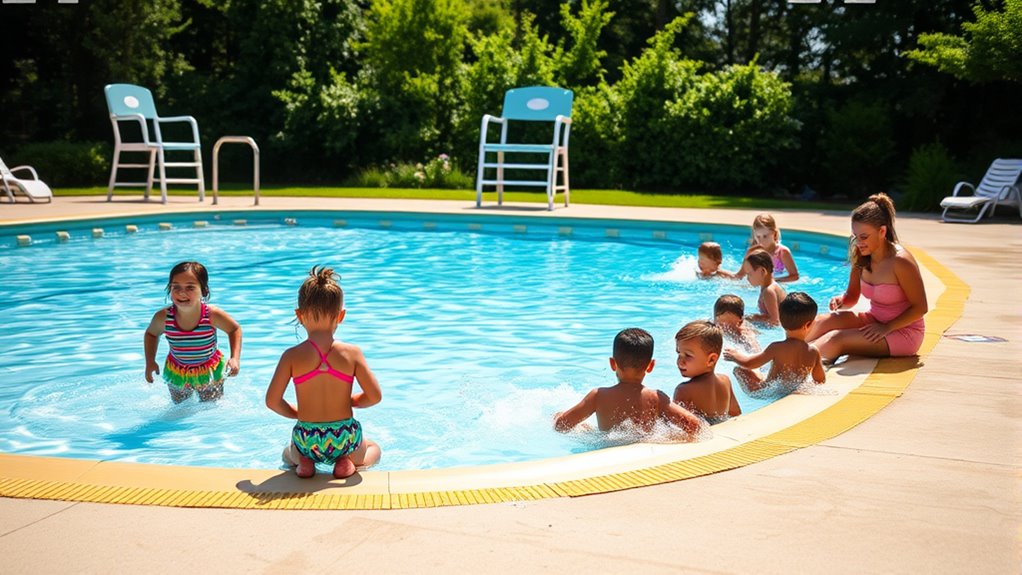
You should always keep a close eye on kids when they’re in the wading pool. Establish clear rules about no running or roughhousing to prevent accidents. By staying vigilant and setting boundaries, you help guarantee a safe and fun water experience. It’s also helpful to familiarize yourself with essential oils for safety that can support calming and soothing when children are upset or anxious during water play.
Constant Adult Supervision
Supervision is essential whenever children are playing in wading pools, as water can be unpredictable and dangerous. When you’re watching kids, stay actively engaged and attentive at all times. Avoid distractions like phones or conversations that take your focus away from the pool. To guarantee safety, keep these points in mind:
- Never leave children unattended, even for a moment.
- Be close enough to reach them quickly if needed.
- Watch for signs of fatigue or distress.
- Regularly scan the entire pool area for potential hazards.
- Understanding water safety guidelines can help prevent accidents and ensure a safe environment.
Establish Clear Rules
Establishing clear rules before children start playing in the wading pool helps set expectations and guarantees everyone stays safe. Clearly communicate boundaries, such as no running or roughhousing, and specify that only designated adults can enter the water. Make sure kids understand that they should stay within the shallow areas and avoid drinking or splashing water into their faces. Use simple language they can remember, and reinforce these rules before and during water play. Consistent enforcement is key—if a rule is broken, address it immediately with calm firmness. When kids know what’s expected, they’re more likely to follow safety guidelines and behave responsibly. Implementing proper supervision significantly reduces the risk of accidents and helps ensure a safe environment for all. Having set rules creates a safer, more enjoyable environment for everyone involved.
Safe Water Temperature and Maintenance Practices
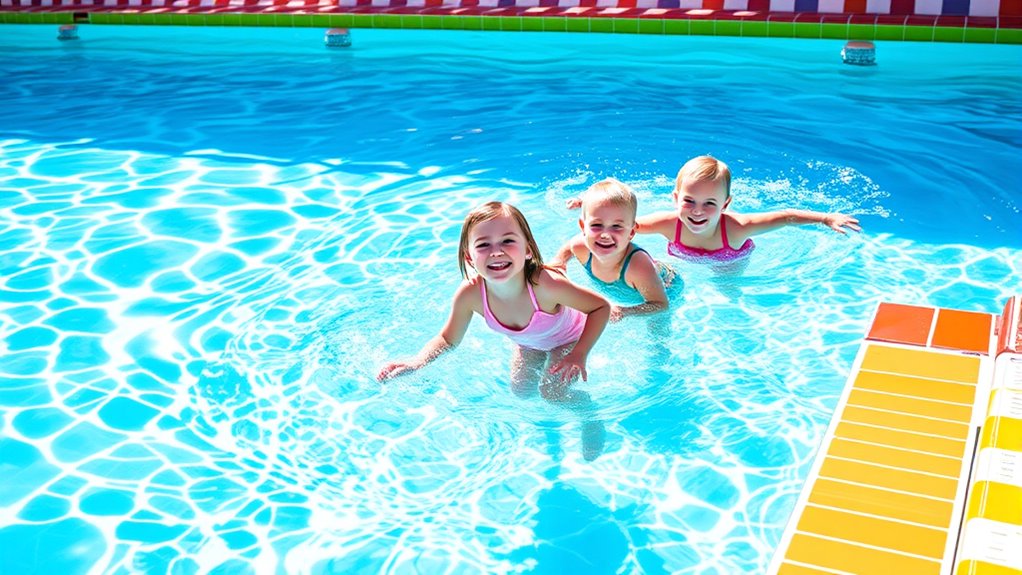
Maintaining the proper water temperature in wading pools is essential for kids’ safety and comfort. Ideally, keep the water between 78°F and 82°F (25°C to 28°C). To guarantee safe and clean water, follow these practices:
- Regularly test the water temperature with a reliable thermometer.
- Change the water frequently, at least daily or whenever it looks murky.
- Use appropriate chlorine or sanitizer levels to prevent bacteria growth.
- Clean the pool and filter system weekly to remove debris and algae.
- Incorporate high-pressure airless paint sprayers for efficient cleaning and maintenance of the pool surfaces and surrounding areas.
Consistent maintenance prevents health issues and keeps the pool inviting. Always monitor water quality and temperature before allowing children to enter, ensuring a safe and enjoyable experience for everyone.
Adding Safety Accessories: Fences, Covers, and Alarms
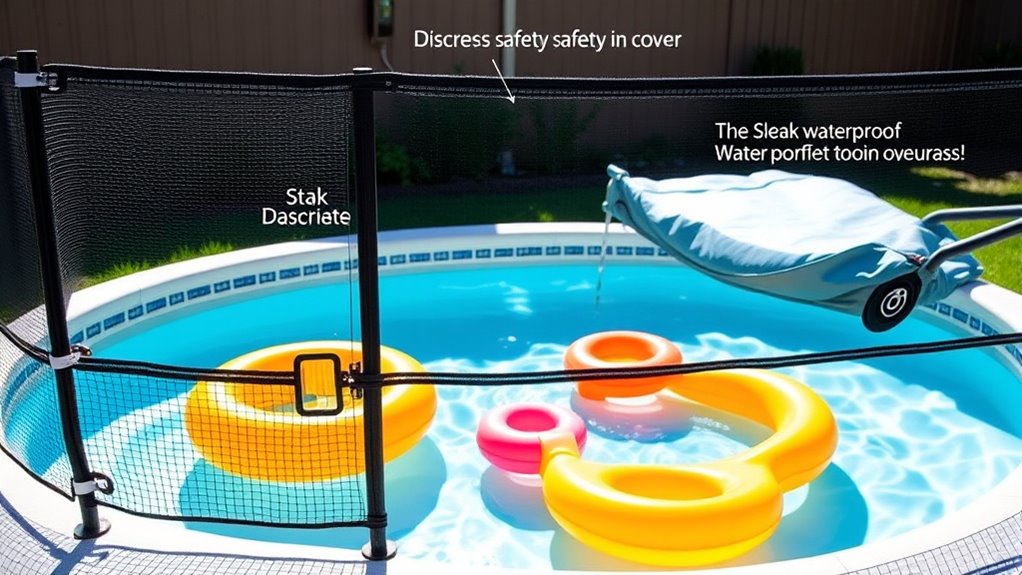
Adding safety accessories like fences, covers, and alarms substantially reduces the risk of accidental drownings and unauthorized access to wading pools. Installing a sturdy fence around the pool creates a physical barrier, preventing children from entering unsupervised. Use a self-closing, self-latching gate to guarantee the fence remains secure. Pool covers provide an extra layer of protection when the pool isn’t in use, preventing falls and keeping debris out. Alarms on gates or doors alert you immediately if someone enters the pool area unexpectedly. These devices act as crucial safety measures, giving you peace of mind and reducing the chances of accidents. By combining fences, covers, and alarms, you reinforce your pool’s safety and create a more secure environment for your kids. Integrating smart safety features, such as alarms connected to mobile devices, can further enhance supervision and response times.
Educating Kids on Pool Safety Rules
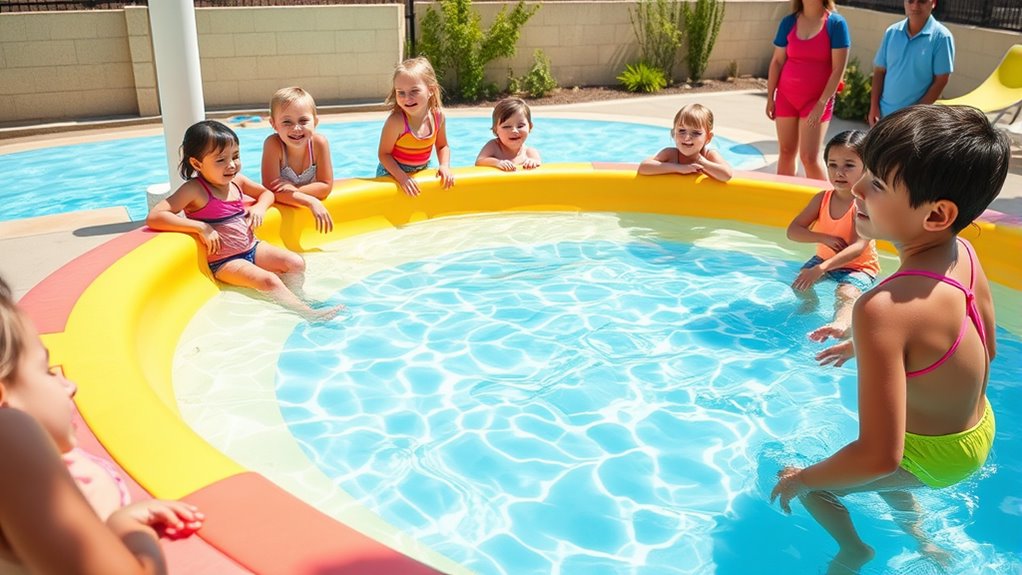
Teaching kids pool safety rules is essential to prevent accidents and make sure they understand how to stay safe around water. You should clearly explain these rules and enforce them consistently. Here are four key points to cover:
- Always supervise children when they’re in or near the pool.
- Never allow running or rough play around the water.
- Teach kids to stay within designated shallow areas.
- Make sure they understand not to enter the pool alone without an adult.
- Reinforce the importance of water safety awareness to help children recognize potential hazards and respond appropriately.
Seasonal Storage and Maintenance for Longevity

To guarantee your wading pool stays in good condition year after year, proper seasonal storage and maintenance are essential. When the swimming season ends, clean the pool thoroughly with mild soap and water, removing dirt, algae, and debris. Drain all water completely and dry the pool surfaces to prevent mold and mildew. Store the pool in a cool, dry place, avoiding direct sunlight that can weaken materials. If your pool has a frame, check for rust or corrosion and repair any damage before storing. During the off-season, inspect the pool regularly for tears or punctures, fixing them promptly to prevent further damage. Proper storage and maintenance extend the lifespan of your wading pool, saving you money and ensuring safe, enjoyable use every summer.
Common Mistakes to Avoid When Setting Up a Wading Pool
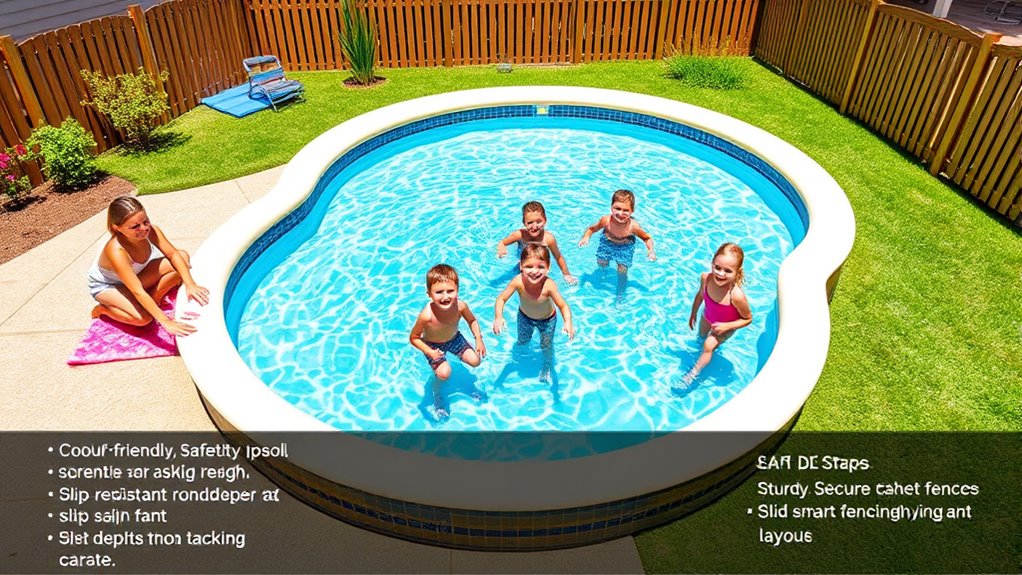
When setting up a wading pool, it’s easy to overlook common mistakes that can compromise safety and durability. To avoid issues, pay attention to these pitfalls:
- Ignoring the ground level—ensure the surface is flat, stable, and free of sharp objects.
- Overfilling the pool—keep water at a safe, recommended depth to prevent drowning risks.
- Poor drainage—set up the pool where water can easily drain away to prevent slipping hazards.
- Skipping maintenance—regularly clean and disinfect the pool to avoid bacteria buildup and algae growth.
Frequently Asked Questions
How Can I Prevent Slips and Falls Around the Wading Pool?
You can prevent slips and falls around the wading pool by keeping the area dry and clean. Place non-slip mats or textured surfaces on the ground, and encourage kids to walk carefully. Supervise children at all times, especially when they’re wet, and remove any toys or obstacles that could cause tripping. Regularly inspect the area for hazards, and remind kids to be cautious near the water.
What Are Eco-Friendly Options for Pool Cleaning and Maintenance?
Opting for eco-friendly pool cleaning options is a wise choice. You can use natural enzymes and mineral-based treatments that break down contaminants without harsh chemicals. Regularly filtering and skimming the water keeps it pristine, reducing the need for chemical interventions. Consider solar-powered pumps and robotic cleaners that minimize energy use. By choosing these sustainable methods, you protect the environment while keeping your pool safe and sparkling for your family’s enjoyment.
How Do I Choose Non-Toxic, Safe Pool Accessories for Kids?
You should look for non-toxic, safe pool accessories made from BPA-free, food-grade, or natural materials like silicone, rubber, or wood. Check product labels for eco-friendly certifications and avoid plastics with harmful chemicals. Prioritize accessories without sharp edges or small parts that could be choking hazards. Always read reviews and choose reputable brands committed to safety and sustainability, ensuring your kids enjoy the pool safely and responsibly.
What Are Signs of Waterborne Illnesses in Children Using the Pool?
You might think your child’s playful splash is harmless, but waterborne illnesses can sneak in with symptoms like diarrhea, vomiting, fever, and stomach cramps. Sometimes, these signs appear hours or days later, making you wonder if the pool was the culprit. Keep an eye out, encourage good hygiene, and guarantee the pool water is properly sanitized. Prevention beats dealing with illness, even if that splash looks innocent.
How Can Weather Conditions Affect Pool Safety and Usage?
You should always check the weather before letting kids swim, as thunderstorms or high winds can make pools unsafe quickly. Rain can dilute disinfectants, reducing water sanitation, while intense sun can cause overheating or sunburn. Strong winds might blow debris into the water, creating hazards. If lightning strikes nearby, it’s safest to get everyone out of the pool immediately. Staying alert to weather conditions keeps everyone safer and prevents accidents.
Conclusion
By choosing the right depth, materials, and safety features, you can create a fun yet secure wading pool for your kids. Remember, proper supervision and education are key to preventing accidents. It’s natural to worry about safety, but with smart planning and attentive oversight, you can give your children joyful summer memories without fear. Trust your instincts—your efforts make all the difference in keeping them safe and happy.
